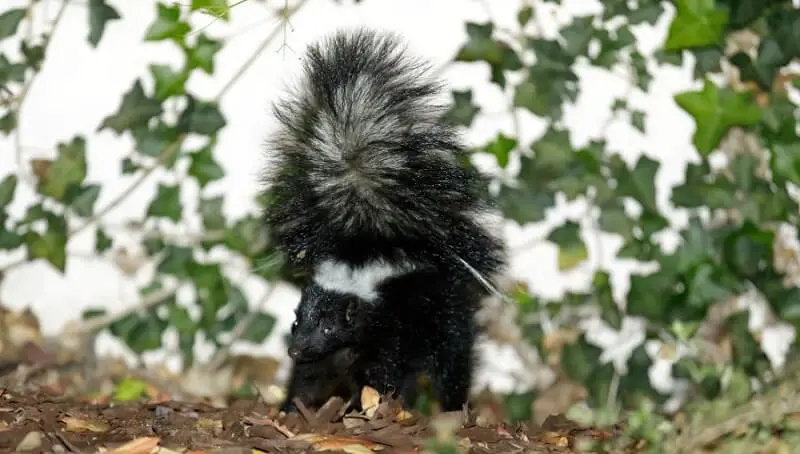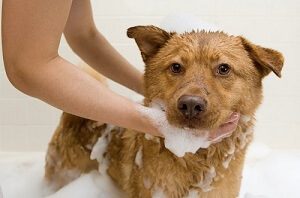
Itching or Scratching in Rabbits
November 3, 2022
Interesting Facts About Penguins
November 4, 2022
Skunks are mammals native to North and South America and are related to animals such as ferrets, badges, and otters. They are members of the Mustelidae family, and while almost every member of this family creates a stinking secretion in their smelly glands, skunks are the only ones who have the ability to spray it with force up to 4,5 meters.
Most dog owners, especially from these areas, are very aware of the skunks and the harmful spray they can produce. So, what can you do when your curious dog gets a little too close to a skunk and gets sprayed? Read on to know not only what you can do to clean your dog, but also what to take care of when your dog is full of skunk spray.
What is skunk spray?
The skunk spray is produced in the glands of the skunk. It is a yellow oil composed of several different, volatile compounds, meaning they become slightly gas, which are called thiols or thioacetates. Thioacetates, although they smell less than thiols, are easily converted to thiols when mixed with water. This is why a dog that has been sprayed by a skunk has a more prominent smell when it gets wet. Thiols also have an obnoxious ability to bind quickly and strongly to skin proteins. The purpose of this odiferous mixture is simply self-defense. When a skunk is scared, it can and will spray this liquid directly on anything that follows it.
Why are dogs sprayed by skunks?
A skunk will spray if it feels threatened. They will often give a few warning signs in advance, such as whistling, kicking their legs, and lifting their tail. If the warnings are ignored, then the skunk will definitely spray. This is their main defense mechanism, which will help them get away from predators, allowing the skunk to escape unharmed. Even a friendly and curious dog can be seen as a threat by a skunk, especially if they approach to sniff.
Dogs can also be sprayed by a skunk when they investigate the garbage or when they explore bushes and piles of branches where skunks may shelter. Usually, the spray is powerful enough that physical fights between dogs and skunks are rare.
What to do if a dog is sprayed by a skunk
- Keep your dog outside
You may be tempted to rush them into the house, but don’t do it! It’ll just spread the smell around your house. Try to clean your dog outside.
- Put on some gloves
Keep calm and put on some gloves and maybe an apron before handling your dog. This will help reduce the contact you make with the skunk spray when handling your pet.
- Check your dog for injuries
The skunk spray could irritate if it gets into your pet’s eyes. Look for signs of inflammation or discomfort, such as red eyes. You may need to gently rinse your dog’s eyes a few times with warm water or eye water. If your dog is foaming at his mouth, you may need to try and rinse his mouth, but be careful not to get bitten if he is stressed out. You could try to offer him water from a bowl if he doesn’t let you wash his mouth. Check for obvious external injuries, such as bite wounds and scratches. Hopefully, it will not be close enough to the skunk to fight but check again, as there is the potential to get infections from bite wounds, such as rabies. Keeping your dog’s rabies vaccines up to date will help reduce the risk of this happening.
- Absorb the skunk spray
Use paper towels to try to absorb as much skunk spray as possible from your dog’s fur. Use a swab motion instead of wiping to prevent the spread of secretions to other areas of the body.
- Wash your dog
Use the remedy recommended below or any other special dog shampoo to wash your dog’s fur. You may need to wash them a few times.
- Consider taking your pet to the veterinarian
If you think your pet is injured or suffering from irritation, call your veterinarian for advice. They may recommend that you bring your dog to the hospital for a check-up.
How to get rid of the skunk smell from a dog?
 If your dog is sprayed in the eye, it may become red and irritated. If this happens, you will want to wash your dog’s eyes immediately. There are various products available on the market that are safe to use in this way. If you live in an area where skunks are common, it wouldn’t hurt to keep some at hand.
If your dog is sprayed in the eye, it may become red and irritated. If this happens, you will want to wash your dog’s eyes immediately. There are various products available on the market that are safe to use in this way. If you live in an area where skunks are common, it wouldn’t hurt to keep some at hand.
When it comes to home remedies to get rid of the skunk smell from your dog, professional pet cosmeticians have seen it all, from the very popular tomato juice to spaghetti sauce and ketchup, lemon juice, mayonnaise, vinegar, and mouthwash. Whatever you were thinking, they saw at least one dog washed with it. While the acid content of some of these products actually helps to remove unpleasant odors by breaking down the oils in the skunk jet, none of them work that well overall.
YOu might also like my articles on what you can do when your dog ate a stink bug, a pen, or a sock.
At the moment, there are effective commercial products that can be found at pet salons, accessory shops, and veterinary cabinets. Some are detergent-based shampoos, while others are enzymatic substances that actually digest odor-causing bacteria.
They can be found in powder or liquid form, and are used in cosmetic salons before bathing. The dogs are first softened with one of these products for at least 15 minutes before being washed. If the dog has been sprayed into the mouth by a skunk, the smell will fix to the mucous membranes of the gums and tongue.
For this, dog mouth sprays are used as they improve the problem. If you do not have any such commercial product at hand, do not despair. Try this home remedy developed by chemists to solve the problem:
- 1 liter 3% hydrogen peroxide;
- 1/4 cup baking soda.
- a teaspoon of dish-liquid detergent.
First, gently wash the dog’s eyes with plain water. When the dog receives a direct attack in the face, the fluid sprayed from the skunk stings and burns the eyes. Then rub the dog’s fur with the solution above, making sure you reach up to the skin and take care not to get it into his eyes.
Rinse thoroughly with warm tap water and then discard any remaining solution. Caution! This product cannot be made early and should not be stored for future use. Because it produces oxygen, this product is flammable and will explode if left in a closed container.
After this wash, use a quality shampoo to restore the coat to its normal state.
You also want to be sure that you only use 3% hydrogen peroxide and not something stronger, as it can be more irritating to your dog’s skin. You may need to repeat this step if your dog is still smelly. Once the solution is completely rinsed, shampoo the dog to remove any residual solution and let the dog smell fresh and clean. Then dry the dog with a towel as well as possible.
If during any stage of this process you feel a skunk smell, you will need to wash your clothes in regular laundry detergent and half a cup of baking soda.
Can I prevent my dog from encountering skunks?
There are cautions you can take to make your yard less attractive for a skunk. Sealing the outer trash can to prevent the animal from entering your trash. If you are feeding dogs or cats outdoors, raise the food and water bowls left outside overnight.
Similarly, if you have bird feeders, pick up any spilled seed daily. If you have a veranda or a shed, a skunk might find the area under those structures perfect for a burrow. You can block the access by sticking wire around or laying bricks. You can also throw naphthalene balls underneath, as they will not appreciate the smell and will go elsewhere.
Skunks can have a bad reputation, especially among dog owners. Knowing the steps you can take when your dog has an unpleasant encounter with a skunk can make the difference between something you can laugh about later, and something that can really affect how your day goes.
